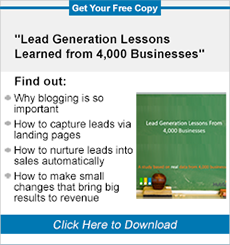Digital marketing should drive customers to your company website, capture warm leads, and nurture them towards Sales.
I get asked this question a lot: How do you create a successful online marketing campaign?

Digital Marketing requires knowledge in a number of areas. It is a hybrid between Sales and Marketing.
Gartner has said that with marketing automation software, companies can bring customers 85% of the way down the sales funnel; And it is absolutely true. The companies that are knocking it out of the park today with high-valued IPOs are taking full advantage of the way customers shop today via the internet.
Digitally-driven leads are 1/3 the cost of leads obtained with traditional outbound marketing methods such as tradeshows.
A beautiful thing about digital marketing is your sales people never have to cold call again. If you do it right you should be able to hand them piles of warm leads which should make them very happy and everyone at the company more money.
Successful digital marketing campaigns require a knowledge of best practices for digital marketing as well as marketing in general. They require creativity to get past the boring factor because people today are bombarded with so many messages and competition for their budget. Digital campaigns require good messaging so you can hook prospects quickly on your solution to their pain point, leaving them wanting to know more.
Here I give you a high-level outline of what it takes to create digital marketing campaigns that capture leads that will close in sales.
5 Steps to Create Effective Digital Marketing Campaigns
1) There Should be Offers at Every Level of the Sales Funnel
Look at what the company has in place for digital marketing campaigns now and consider who is the target audience for the company's products or services.
I come into companies and they might have a good Technical Blog and How-to Videos, and a Whitepaper, but no middle-or-bottom-of-the Sales funnel offers. By fixing that, the leads flow in and Sales go up; Really, it's like magic!
First you need to drive traffic to the company website, raise awareness of the company's offerings and sometimes even the product category using top-of-the-sales-funnel offers.
Top of the Sales Funnel Offers
Top-of-the funnel offers should state clearly what kind of pain points your offerings solve so your target customers can self-identify as needing your offer. This is what will motivate them to download your offer becoming a marketing-qualified lead (MQL). Top-of-the-funnel offers include:
- Blogging to get found via organic traffic on search engines, blog articles can and should also be pushed out to social media
- Email blasting engaging educational offers to people with target titles at companies in target market segments
- Brightly colored-call-to-action buttons for educational offers published directly to social media to drive awareness of your product or category, build brand awareness and traffic
- Games, Infographics, eBooks, Tip Sheets, WhitePapers
- Webinars addressing market needs such as a standards-body expert along with your CEO
- How-to Videos
Middle of the Sales Funnel Offers
Middle-of-the-funnel offers are sent to MQL via email lead-nurturing campaigns and placed on related website pages as well. These are for prospects that are in an evaluation or comparison stage. Middle-of-the-funnel Offers give them more information. It helps them evaluate how your solution will fit into their organization. At this stage, prospects are comparing you with your competitors.
- Indepdendent research which shows, in example, that all IT Managers have the same problem they do
- Case Studies showing your product solved the problem for other companies and the ROI they achieved
- a 'Kit"with ROI justification, blog articles, and "how to" videos
- Product demonstration webinars, Testimonials, ROI Calculators
- Buying guides, Consultations, Product demo videos
- Video of keynotes or speaking engagements
- Data sheets, Product comparisons/pricing guides, Blog posts with more in-depth content
Bottom of the Sales Funnel Offers
Offers at this stage must continue to educate prospects, but should also challenge them to think differently about your solution. Content with data, facts, and third-party involvement is productive at this stage.
- Chart with Competitive Analysis
- Free trials
- "Deep dive" product demos
- Follow up consultations
- Customized estimates
- Coupons/offers
- In-depth blog posts or articles
- Testimonials
2) Look at Past Performance and Analytics in Marketing Automation Software
Ask questions from current sales and marketing people. Find out what has worked in the past and what has fallen flat. Some of my best campaigns are born out of addressing problems that were identified in the past.
Look at campaign performance in Marketing Automation Software. You can achieve a lot very quickly by learning from marketing analytics. You can find out which keywords drive the most traffic, which emails, blog articles, offers and social media campaigns bring in customers. You will probably discover that customers follow different paths into your company, but that specific campaigns outperform others. You can use A/B testing to improve email titles and CTA buttons to optimize campaigns. You will see that usually customers require 5 interactions with your messaging before their lead score climbs high enough to warrant a call from sales.
Study buyer personas by analyzing the last 10 sales to properly target your campaigns. Find out what commonalities exist between customers who have already purchased your product. Below are a few examples of positive changes we made after asking the existing team what is and isn't working:
Example One) I was told by the product managers that their demos going through all the bells and whistles of their software seemed to bore the customers. So, working with the same product managers, we created a jumpstart webinar series that used real-world-well-known-security incidents to show the product's features and benefits that would have mitigated or stopped the threat at each step of the disaster, which were very well received.
Example Two) The company told me they had a problem getting the IT and OT departments to want to work together and buy their software which tied together seemingly unrelated events to detect security threats. So I created a game that was called, "Can You Name This Security Disaster that Involved Both IT and OT?" It had radio buttons so the prospects could guess at well-known security disasters. The game concretely demonstrated how all of the security incidents involved both IT and OT; This established the need for the company's software firmly in their prospect's minds.
Example Three) The CEO at a company told me, when I asked, that it would be good to have a way to show the high-level Financial Gatekeeper at companies why they should buy the software in order to shorten the sales cycle. The company had a lot of technical "how-to" videos and blog articles that drove traffic to the site and convinced IT to buy the company software. They just needed more middle and bottom-of-the-sales-funnel offers to get their prospects all the way there.
I created an "IT Kit with ROI Justification" that received ~3,000 downloads and a video that gave a 50K-ft-view of pain points solved in order to shorten sales cycles. Sales loved them and set 160% more appointments using an Intro Letter we created. Threw in an eBook, and it worked like a charm, revenue increased significantly, by 50% in just 6 months, after 8 years of flat sales.
Always look at analytics to see what you can replicate and improve, as well as interview the team to discover what they have already learned about their business before creating new campaigns.
3) Research
Keep in mind the following strategic marketing elements when designing campaigns:
- Customer Requirements
- Market Landscape
- Competitive analysis for positioning
- ROI Justification and ROI Anaylisis
- Emerging Technologies, Standards, and Trends
- Partering Solutions to create "Whole Product" Offerings
- Marketing Mix (4Ps and 5 Ms)
4) Messaging
Make sure messaging speaks to the customer pain points solved, the ROI for the customer, and is creatively engaging but to the point. The customer shouldn't have to dig or think too hard about how your solution makes their life easier. If anything, your messaging should describe the exact problem the customer is facing in as realistic a way as possible. Nobody is going to believe your company can solve their problem if you don't even know what it is.
5) Digital Marketing Best Practices
There are lots of things to know about digital marketing best practices. You need to know a lot more than how to use Marketo or Hubspot, you need to know what elements should be included in campaigns and why. Below I share a few rules and links to get you started.
- All offers should be educational, no freebies like starbucks gift cards or visas. Those don't attract real leads, they attract people who want free stuff which are seldom people with serious jobs.
- Blogging tips: 16 Facts You Can't Afford to Ignore About Blogging and SEO
- Call-to-Action Tips Best Practices for Calls to Action
- Landing Page Tips: Top 10 Tips for Landing Page Optimization
- I could put a lot more links here, like "How to Make a Video That Sells" or "Top 3 Titles to Hook a Reader", "40 Landing Pages Generate Ten Times the Leads" and 300 more. Please check out the rest of my blog for more tips and tricks for doing great digital marketing at www.bayareainbound.com/blog
So there you have it, a high-level view in 5 steps on how to create effective Digital Marketing Campaigns that will actually close in sales and increase revenue.
-----------------------------------------------------------------------------------------------------
Bay Area Inbound is a full-service Inbound Marketing Agency in the SF Bay Area that specializes in campaign creation and lead generation to significantly increase revenue for technology companies.
For more information on getting traffic to your site and generating the leads you need, contact laurie@BayAreaInbound.com or 510-543-7593. Download our free whitepaper below:

